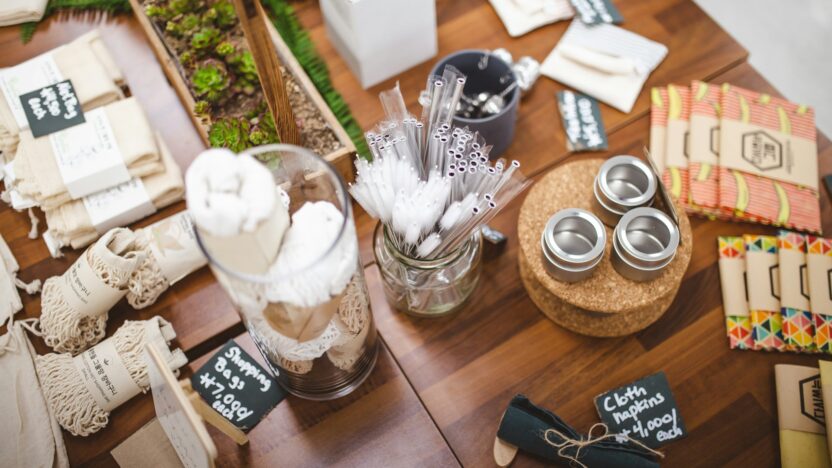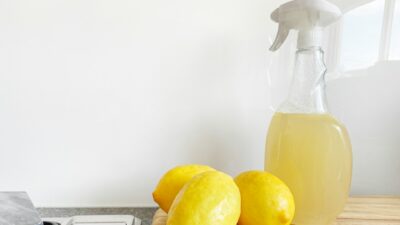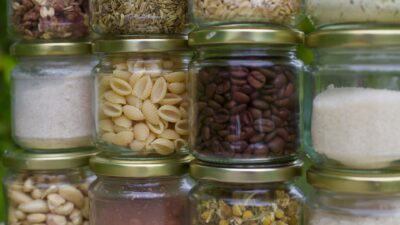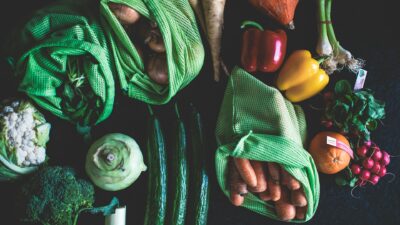Creating your own zero-waste products is a fun, affordable way to reduce waste while personalizing your home. Homemade items like reusable napkins or beeswax wraps replace disposables, saving money and keeping trash out of landfills. Plus, DIY projects let you get creative and use sustainable materials. This guide shares easy zero-waste crafts you can make at home, perfect for beginners. For more eco-friendly ideas, visit For Organic Life.
Crafting Reusable Cloth Napkins and Bags
Reusable cloth napkins and bags are simple to make and cut down on single-use waste like paper towels or plastic bags. Here’s how to get started:
- Cloth Napkins: Choose organic cotton or linen fabric for durability and sustainability. Cut into 12×12-inch squares (or larger for dinner napkins). Fold edges over twice, about 1/4 inch, and sew with a straight stitch to prevent fraying. Use scraps from old shirts or tablecloths to save money.
- Produce Bags: Cut lightweight cotton or mesh fabric into 10×14-inch rectangles. Sew three sides, leaving one open. Add a drawstring by folding the open edge over 1/2 inch, sewing a channel, and threading with a cotton cord. These are perfect for bulk shopping or storing produce.
No sewing machine? Use fabric glue or hand-stitch for smaller projects. Wash napkins and bags with eco-friendly detergent to keep them fresh. These items are easy to customize with natural dyes or patterns, adding style to your zero-waste routine. Start with a set of four napkins or two bags and scale up as needed.
Making Homemade Beeswax Wraps
Beeswax wraps are a reusable alternative to plastic wrap for storing food. They’re moldable, washable, and compostable, making them a zero-waste kitchen staple. Here’s a simple recipe:
- Materials: Organic cotton fabric, beeswax pellets, jojoba oil, and pine resin (optional for stickiness). You’ll also need a baking sheet, parchment paper, and an oven.
- Steps: Cut fabric into squares (8×8 or 12×12 inches). Place on a parchment-lined baking sheet. Sprinkle evenly with 2 tablespoons beeswax, 1 teaspoon jojoba oil, and 1/2 teaspoon pine resin per square. Bake at 225°F for 5-7 minutes until melted. Brush to spread evenly, then hang to dry.
- Use and Care: Wrap food or cover bowls by pressing with your hands to mold. Wash with cool water and mild soap, then air dry. Wraps last about a year with proper care.
Source beeswax and fabric from local craft stores or online zero-waste shops. Test a small piece first to perfect your technique. Beeswax wraps keep food fresh and reduce plastic waste, making them a must-have DIY project.
Creating DIY Cleaning Products
Homemade cleaning products replace disposable wipes and chemical sprays, saving money and reducing plastic waste. Here are two easy recipes:
- All-Purpose Cleaner: Mix 1 cup water, 1 cup white vinegar, and 10 drops of lemon or tea tree essential oil in a reused glass spray bottle. Shake before use. Great for countertops, sinks, or glass.
- Scrub Paste: Combine 1/2 cup baking soda, 2 tablespoons castile soap, and a few drops of water to form a paste. Store in a jar. Use for tough stains on pots or bathroom tiles.
Always test cleaners on a small area to avoid damage. Use reusable cloth rags (made from old T-shirts) instead of paper towels to apply. Store products in cool, dry places and label clearly. These cleaners are safe, effective, and eco-friendly, keeping your home clean without waste.
Upcycling Household Items for Zero-Waste Solutions
Upcycling turns everyday items into useful zero-waste tools, reducing the need for new purchases. Here are some creative ideas:
- Jar Organizers: Reuse glass jars from sauces or pickles to store spices, snacks, or utensils. Paint lids with non-toxic chalk paint for labeling.
- Towel Rags: Cut worn-out towels or clothes into squares for cleaning rags. Sew edges to prevent fraying or leave as-is for quick use.
- Crate Shelves: Turn old wooden crates into pantry shelves or storage for bulk goods. Sand and seal with non-toxic finish for durability.
- Tin Can Planters: Clean empty tin cans and drill drainage holes to make herb planters. Paint with non-toxic paint for a pop of color.
Check your home for items to repurpose before buying materials. Use non-toxic glues, paints, or finishes to keep projects eco-friendly. Upcycling saves resources and adds unique charm to your zero-waste lifestyle. Visit thrift stores or ask neighbors for extra materials to spark new ideas.
Sourcing Sustainable Materials for DIY Projects
Using eco-friendly materials ensures your DIY projects align with zero-waste goals. Here’s how to source them:
- Fabric: Choose organic cotton, hemp, or linen from fabric stores or repurpose old clothing. Look for GOTS-certified fabrics for sustainability.
- Beeswax and Oils: Buy beeswax pellets and jojoba oil from local beekeepers or zero-waste shops. Ensure they’re organic and ethically sourced.
- Jars and Containers: Reuse household jars or check thrift stores for glass or metal containers. Sanitize before use.
- Tools: Use existing sewing kits, scissors, or paintbrushes. Borrow from friends or buy secondhand to avoid new plastic tools.
Shop at local markets, co-ops, or online retailers like Package Free for sustainable supplies. Ask for package-free or recyclable packaging when ordering. For more sourcing tips, explore For Organic Life. Choosing green materials keeps your projects truly zero waste.
Crafting a Zero-Waste Future
Making your own zero-waste products is a rewarding way to live sustainably. By crafting reusable napkins and bags, beeswax wraps, cleaning products, upcycling items, and sourcing eco-friendly materials, you can reduce waste with creativity. Start with one project and let your skills grow. Enjoy the process of building a greener home!




